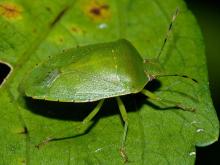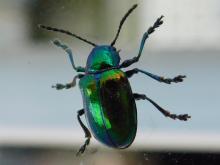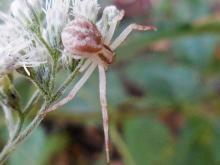Land Invertebrates
Media

Species Types
Scientific Name
Chinavia hilaris (formerly Acrosternum hilare)
Description
The green stink bug is one of many species of stink bugs. Like others in their family, they emit a foul odor when they are harassed or crushed.
Media

Species Types
Scientific Name
Chrysochus auratus
Description
The shiny, iridescent dogbane beetle is one of Missouri's most beautiful insects. As the name indicates, this beautiful beetle feeds on dogbanes.
Media

Species Types
Scientific Name
Zelus luridus
Description
The pale green assassin bug, Zelus luridus, is one of nearly 200 species of assassin bugs in North America. Like other assassin bugs, it is a predator that captures and eats other insects.
Media

Species Types
Scientific Name
Mecaphesa asperata
Description
The northern crab spider has many spiny hairs covering the top surfaces of the carapace, abdomen, and legs, and it has usually has greenish-yellow or yellow-brown markings.
Media

Species Types
Scientific Name
Misumessus oblongus (formerly Misumenops oblonga)
Description
The green crab spider has spines, and the entire body and legs are pale green to silvery white. Like other crab spiders, its legs extend outward from the sides, and it can walk in any direction.
Media

Species Types
Scientific Name
Schistocerca spp.
Description
About six species of bird grasshoppers occur in Missouri. Most are attractively marked, large insects that gracefully fly from danger, almost like birds.
Media

Species Types
Scientific Name
Cicindela limbalis
Description
The common claybank tiger beetle, or green-margined tiger beetle, occurs on dirt clay soils in open areas in spring and, less abundantly, in late summer. Color varies from red to purple to green. The outer shell edges are often edged with shiny green.
Media

Species Types
Scientific Name
About 2,000 species in North America north of Mexico
Description
Plant bugs, or mirids, are a huge family of true bugs. They are often overlooked — except by gardeners and farmers. Most mirids eat plants, and some are agricultural pests. As a group, they’re an important food source for birds and other insectivores.
Media

Species Types
Scientific Name
Scudderia furcata
Description
The fork-tailed bush katydid reaches about 1¾ inches long. It is usually leafy green and is most common in bushes, thickets, and other shrubby areas. It is most active after dusk. The call is a simple "tsip!" given every few seconds.
Media

Species Types
Scientific Name
About 1,300 species in North America north of Mexico
Description
The longlegged flies are a large, diverse fly family. They often have eye-catching metallic green, copper, bronze, or blue bodies and long legs. Their delicate wings are often clear and look iridescent in bright light, but many species have dark marks near the wing tips.
See Also



Media

Species Types
Scientific Name
Cisseps fulvicollis
Description
The yellow-collared scape moth is more often “orange-collared.” And whether you think it looks more like a firefly or a wasp, it’s still a moth!
Media

Species Types
Scientific Name
Nearly 150 species in North America north of Mexico
Description
Slim, delicate plume moths are instantly recognizable by their T-shaped silhouette, long legs, and muted shades of tan and brown. It can be hard to separate the various species.
Media

Species Types
Scientific Name
Pyrrharctia isabella
Description
Not many people know the adult Isabella tiger moth when they see one, but we’re all acquainted with its caterpillar, the woolly worm, or woolly bear.
About Land Invertebrates in Missouri
Invertebrates are animals without backbones, including earthworms, slugs, snails, and arthropods. Arthropods—invertebrates with “jointed legs” — are a group of invertebrates that includes crayfish, shrimp, millipedes, centipedes, mites, spiders, and insects. There may be as many as 10 million species of insects alive on earth today, and they probably constitute more than 90 percent all animal species.





















